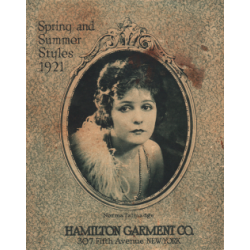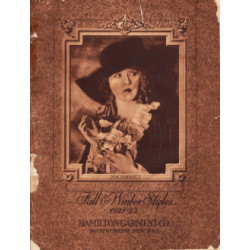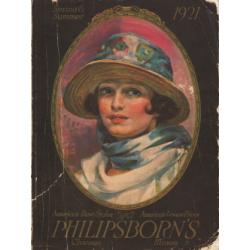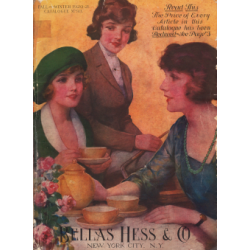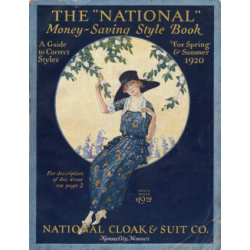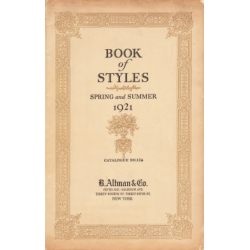Fashion 1920 - 1921
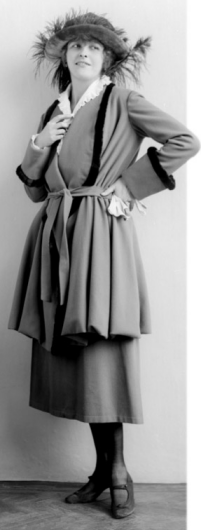 Dress of the Wiener Werkstätte after a design by Eduard Josef Wimmer-Wisgrill — black and white negative on glass plate, 18 x 24 cm. Photo: Atelier Madame d'Ora, Vienna (1881-1963). Courtesy of the Austrian National Library. Source: ONB/Vienna BAG 204.301-D
Dress of the Wiener Werkstätte after a design by Eduard Josef Wimmer-Wisgrill — black and white negative on glass plate, 18 x 24 cm. Photo: Atelier Madame d'Ora, Vienna (1881-1963). Courtesy of the Austrian National Library. Source: ONB/Vienna BAG 204.301-D
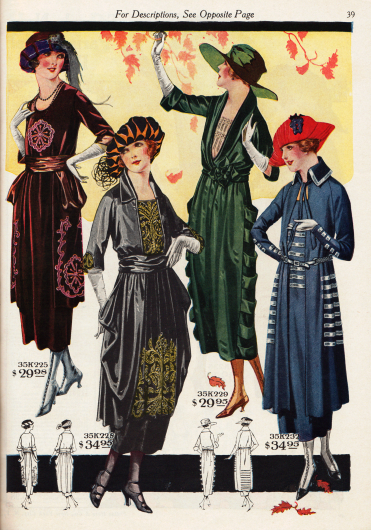 Elegant velvet and satin street dresses with rich silk embroideries
—
Bellas Hess & Co. Fall/Winter 1920, p. 39
Elegant velvet and satin street dresses with rich silk embroideries
—
Bellas Hess & Co. Fall/Winter 1920, p. 39
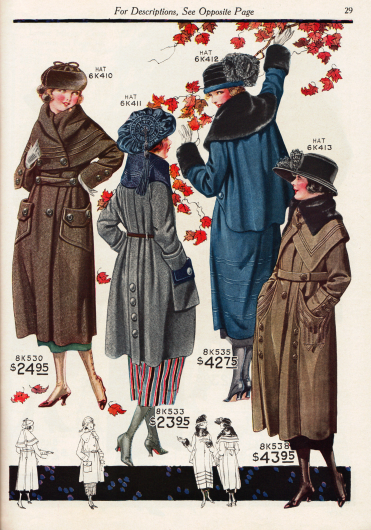 Fall coats for young ladies made of woolen fabrics with oversized collars and with wide cut
—
Bellas Hess & Co. Fall/Winter 1920, p. 29
Fall coats for young ladies made of woolen fabrics with oversized collars and with wide cut
—
Bellas Hess & Co. Fall/Winter 1920, p. 29
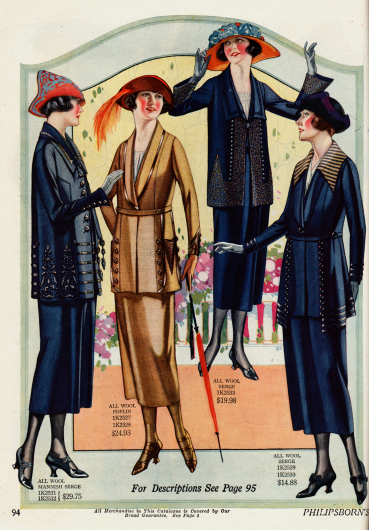 Tailor made costumes made of wool serge and wool poplin. The jackets are decorated with embroidery and decorative buttons
—
Philipsborns Spring/Summer 1921, p. 94
Tailor made costumes made of wool serge and wool poplin. The jackets are decorated with embroidery and decorative buttons
—
Philipsborns Spring/Summer 1921, p. 94
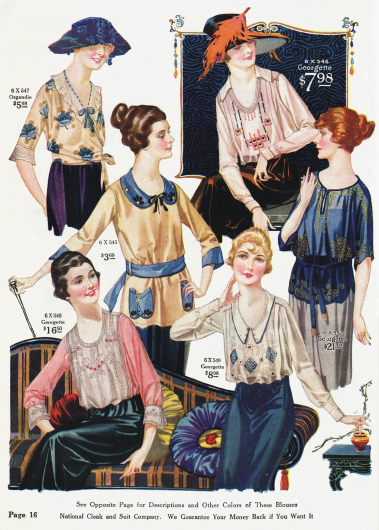 Blouses with small or without collars, with half-length or long sleeves. A smock blouse in the middle left
—
National Cloak & Suit Co. Spring/Summer 1920, p. 16
Blouses with small or without collars, with half-length or long sleeves. A smock blouse in the middle left
—
National Cloak & Suit Co. Spring/Summer 1920, p. 16
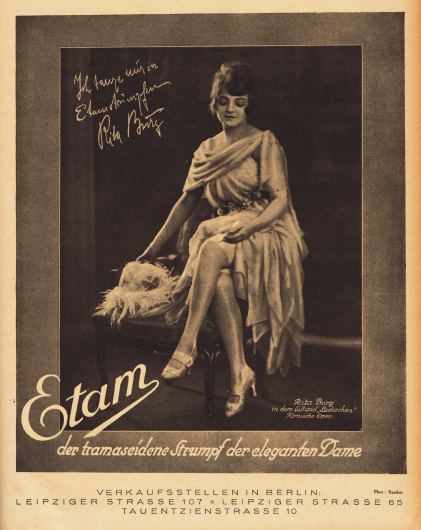 Etam advertisement - the elegant silk stocking of the sophisticated lady presented by actress Rita Burg — Elegante Welt No. 10, May 1921. Photo: Sandau
Etam advertisement - the elegant silk stocking of the sophisticated lady presented by actress Rita Burg — Elegante Welt No. 10, May 1921. Photo: Sandau
At the beginning of the 1920s, post-war fashion changed very little. However, by 1921, the skirt hems become even shorter and now almost end on the calf. In contrast, the skirts are cut even narrower towards the hem. Also the waist, which in 1919 was still very high, slowly begins to slide down towards the natural waist. The waist loosens and is no longer quite as tight. In general the dresses are cut very wide and loose.
The special emphasis on the hip area, on the other hand, remains and some skirts are draped with the help of cascade-like fabric draping or additional fabric panels at the hips in such a way that a breading effect (hoop skirt effect) is created. However, emphasizing the breast is not the intention of current fashion; a flat breast is preferred.
Summer Dress 1920
Particularly attractive and delicate spring and summer dresses made of silk and crepe fabrics are often combined with coarse-meshed net fabrics. The net fabric is also used for blouses.
The neckline of day dresses is moderately wide and only allows a view of the base of the sternum. Mostly round, the neckline is often square cut. Overhanging collars, which have been so fashionable in recent years, are still popular for fine and light summer dresses, but are becoming increasingly rare for normal day dresses.
Finest Embroideries Give a Special Touch
Especially for the finer and more exquisite costumes, blouses and dresses for day and afternoon, special emphasis is placed on elaborate embroidery, preferably created from silk or even pearls. In this case, attention should be paid to the colour coordination of the embroideries in order to achieve a harmonious effect. Mostly these embroideries can be found on the skirts, the bust or also on the bust neckline
Blouses Show Imaginative Variety
The blouses of the season promise an almost inexhaustible variety and are waisted at the natural waist. The round neckline is preferred for most blouses. V-shaped and square necklines are also not uncommon, but these are more reserved for tailored blouses. Blouse collars vary from simple lace borders and frills to large sailor collars. But many blouses also do without a collar altogether.
Especially in summer the sleeve lengths vary between elbow-length and long. The cuffs are sometimes bell-shaped, sometimes provided with facings or lace or tightly fitting with cuffs. Rich silk embroideries are mainly at the waist.
Kasacks - long blouses with a lap - are common for sporting activities, leisure and casual occasions and are worn tied at the waist with a ribbon or belt that matches the material of the Kasack.
Evening Fashion is Experiencing a Renaissance
With the end of the war and the overcoming of the worst effects of war, such as the rationing of cloth and the gradual economic normalization that came with it, the desire for diversion and amusement is greater than ever. This is what the Austrian fashion magazine Record noted in its November 1921 issue:
"One true dance frenzy has taken over the world, one pleasure chases another, theatres and nightclubs are overcrowded, it is the great triumph of the evening toilet."
Thus the great evening toilet regains its full rights. Expensive fabrics of seductive elegance such as heavy metal brocade, exotically patterned silk fabrics, shimmering pearl tulle, changeant taffeta and velvet are used, apparently trying to make up for the need for luxury and glamour that had to be painfully missed during the barren wartime period.
The stylish dress with a wide flared skirt takes a high position in the current evening fashion. The designs and make-up of the dresses remind us of the Middle Ages, then again of a new prince's suit or even of peasant costumes. Sashes and trains give the evening dresses something fluttery and lively. The neckline is held on one side, but - in contrast to daytime fashion - shoulders may also be shown here.
Overcoats in Oversized Cut
The coats follow the dresses in their wide cut, often cut so generously that the wearer almost seems to lose herself in the coat. In the back of the coats, folds are often worked into the back of the coat to create a panel-like effect. The collars tend to be so full and wide that one can rather speak of capes, which tend to overlap the shoulders and upper arms and make a scarf superfluous due to their bulky nature. Similar to the collars, also the cuffs are oversized in order to correspond to the optical overall impression. Large pockets and fashionable buttons complete the picture.
Most coats are the same length as the dresses. But also shorter coats, three-quarter length coats and jackets are still very popular. The processed coat fabrics of the 1920/21 winter season range from fur fabrics to plush and soft woollen fabrics such as velour, polo and polo-velour fabrics. Although brown tones dominate the coat fashion, black, dark blue or even burgundy red coats can also be seen on the streets.
In the 1921/22 winter season, coats increasingly lose their shape and fall straight but wrinkle from shoulder to hem without much emphasis on the waist. Coats that are as long as a dress have gained acceptance.
Fur an Integral Part of Winter Fashion
Coats with fur trimmed collars, cape or hems are indispensable and sought after by women of all classes. Those who can afford it wear a fur coat made of mole, seal or wolf fur. For example, the autumn/winter catalogue of the Montgomery Ward company from 1920/21 contains a fur coat made of Hudson seal fur for an exorbitant $595.00 (over $7,000 according to today's value). The more exotic the fur, the more expensive and sought after it is. But also cheap imitation furs make us believe in prosperity. The elegant lady wears lamb leather gloves in winter and to keep her hands warm she also wears a fur muff. This also gives for the little lady.
Lace-up Boots for Winter
High-necked, very pointed lace-up boots still dominate fashion in winter. The heels have either low military heels or slightly higher, curved Louis XIV heels. The favourite colours for silk stockings are black, brown, grey or white, which correspond to the colour of the shoe.



